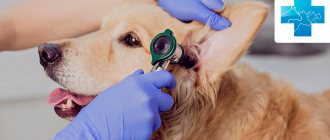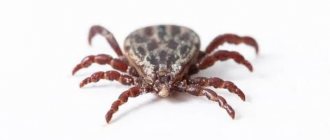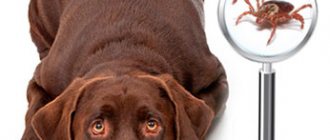What is an ear mite
What does a parasite look like? This is a very small insect, not reaching one millimeter, with a greyish-white translucent body, with a gnawing mouthpart. It gnaws through the skin and makes passages under it, laying eggs in them.
Ear mites under a microscope
The wounds become inflamed and fester. The larvae, feeding on the products of suppuration and lymphatic fluid, reach sexual maturity after 3-4 weeks, and then also lay eggs. In a short period of time, an ear mite can damage not only the skin of a dog’s ear, but also the eardrum, and further penetrate into the inner ear and brain.
The disease develops unnoticed - when the animal begins to show signs of the presence of a tick, then, as a rule, a significant part of the ear is affected. In addition, it was noted that the activity of the insect is subject to some cyclicity: a period of activity and bright symptoms is replaced by more or less calm intervals. This may be due to the cyclical development of the parasite. When pathology takes on threatening forms, there are no periods of rest.
Concept and characteristics of otodectosis
Otodectes cynotis is a parasitic disease caused by the microscopic mite otodectes cynotis. The parasite cannot be distinguished with the naked eye. Its appearance can only be known by its characteristic symptoms.
Pathogen
Otodectes cynotis is an arthropod arachnid whose body size is no more than 0.6 mm. It uses lymph extracted inside the ear canals as a source of food.
In search of food, this tiny pest digs numerous passages in the skin, where it subsequently lays its eggs. Secondary infection often penetrates into the resulting wounds. Because of this, the damaged areas become inflamed and fester.
In addition to lymph, grown larvae readily feed on accumulated exudate and sulfur. Within a month, they turn into adults and increase the affected area, penetrating deeper and deeper. The activity of the tick causes severe anxiety to the infected animal, which helps to recognize the disease at the earliest stages.
Difference from other ticks
In size, otodectes cynotis is close to the causative agents of notohedrosis and sarcoptic mange, but it differs from them in symptoms and treatment methods. When a dog is infected with ear mites, only one area is affected: exclusively the inside of the ears, so medications to kill parasites are instilled directly there.
Does the disease have a seasonality?
Otodectosis affects animals at almost any time of the year, since the activity of the pathogen depends little on the ambient temperature. The microclimate inside the ear is stable, so the mite living in it does not hibernate.
A quick note:
Ear parasites in dogs are sensitive to heat, so they are most active between March and November.
Death from temperature changes occurs only outside a living organism. At 3-7°C otodectes cynotis dies within 24 days, and at -5°C – within 5 hours.
How can a dog become infected with ear mites?
Ear mites can be transmitted from one animal to another, regardless of what stage of development it is at. During itching, the dog intensively scratches its ears, contributing to the spread of the parasite throughout the entire surface of the body. That is, the tick and its transitional forms can be located anywhere the pet is.
A healthy animal can “catch” ear mites in the following ways:
- upon contact (even fleeting) with a carrier animal;
- through a grooming item used by an infected dog;
- from a person who had contact with an affected representative;
- through fleas (they can carry tick larvae);
- from the mother (in puppyhood).
Routes of infection
The pathogen is dangerous in any form. When an infected dog scratches, it spreads parasites from its ears throughout its body, so they can easily spread to other animals.
Sources
Adult mites grow in a dog's ears through direct interaction with a sick animal - or through contact with contaminated things. Even a fleeting sniff is enough for infection.
“ Eggs and larvae are usually transmitted by the bites of insect vectors (flies, fleas).
Contaminated shoes and clothing can also become a source of infection.
Animals at risk
Active reproduction of the small pest begins when immunity declines and/or hormonal imbalances occur. Most often the disease is diagnosed in:
- puppies under 6 months;
- pregnant females;
- elderly dogs;
- pets weakened by chronic diseases or recent surgery;
- animals living near the forest or actively hunting.
Also at risk are breeds with long ears and fur: dachshunds, basset hounds, Yorkies, spaniels and beagles. The risk of infection increases with crowded housing, so if you breed the listed pets, be especially careful.
Symptoms of ear mites
You can suspect ear mites in a dog if you find a dirty brown mass in the external auditory canal. It is formed from skin scales, particles of the outer integument of shed parasites, and the secretion of the ear glands. All this is mixed with purulent discharge from damaged areas of the epidermis and mite excrement, and leads to severe skin irritation and an inflammatory process.
Other ear mite symptoms:
- hyperemia of the skin of the ear canal;
- severe itching;
- swelling of the ear folds.
The dog is nervous, shakes its head, and often itches. When scratching or shaking the ears, particles of accumulated mass may fly out of the external auditory canal.
Briefly about the main thing
- The ear mite Otodectes cynotis is a microscopic parasite that lives inside the ear canal, pierces the epidermis and feeds on lymph.
- Otodectosis is dangerous because it is complicated by otitis media, and in advanced cases can even lead to death.
- Dogs become infected after contact with another sick dog or cat.
- The most specific symptoms are severe itching and dark brown discharge with an unpleasant odor from the ears.
- For quality treatment, it is necessary to clean the ear canal at least twice a day.
Have we answered your question fully enough? If not, post your question in the comments below and our veterinarian will answer it.
Did you like the article? Share it with your friends on social media. networks. This will help them get useful information and support our project.
Diagnostics
Diagnosing ear mites in dogs is not difficult: during the examination, the veterinarian will take material from the ear and look at it under a microscope. In the chronic form, bacterial seeding of the contents of the ear canal may be required to determine the sensitivity of the insect to drugs and to select the optimal drug. In advanced cases, a specialist may prescribe an X-ray examination or computed tomography to identify the condition of the inner ear and membranes of the brain. Additional diagnostic procedures include: bacterial analysis, scrapings, and allergy tests.
Treatment regimen
Otodectosis therapy is performed in 2 ways:
- External. The ears are treated with drops, ointments, and sprays.
- Injectable. Drugs that kill ticks are injected under the skin - “Ivomek”, “Cydectin”, “Aversect-2” in a dosage of 1 ml per 5 kg of weight.
Ear mites are a close relative of spiders. Therefore, acaricides are used against it.
The injection method is better: the toxin enters the body of ticks along with the blood and lymph they eat. But it is rarely used: it is prescribed in advanced cases, when the pathology lasts 2-3 months, and purulent otitis has joined otodectosis.
External treatment for ear mites in dogs is most often used. It's easy to do at home yourself. The following scheme is effective, proven over the years and by thousands of owners:
- cleansing the external auditory canal with an antiseptic (chlorhexidine, hydrogen peroxide);
- lubricating the affected areas with aversectin ointment - twice with an interval of once every 3-6 days;
- treatment with acaricidal solutions, drops or sprays - “Stomazan”, “Amitrazin”, “Butox”, etc.
Ointment or gel must be used in addition to solutions - parasites do not lay eggs in a fatty environment. Both ears are treated, even if one is affected - over time, the mites will migrate to the second.
Fleas, worms and ticks are an inseparable trio. They carry each other's eggs. Therefore, dogs are given anthelmintic tablets and antiparasitic drops are dripped onto the withers.
At the same time, they do antiparasitic treatment at home, because Parasites are able to live in the external environment for 5-20 days. “Butox” or “Neostomazan” is diluted in water. Pour the solution into a spray bottle and spray carpets, baseboards, upholstered furniture, window sills, and doorways. During this time, the animals are taken out of the house.
Before treatment, a diagnosis is made - they take a scraping and examine it under a microscope. It is advisable to conduct a bacteriological culture for staphylococcus or streptococcus, and examine the ears under a Wood's lamp to rule out fungal infection. If infections occur, antibiotics or antimycotic drugs are prescribed.
How to prepare your ear for treatment
Any anti-mite medicine is ineffective if applied to dirt and sulfur. Therefore, before acaricidal treatment, the auricle is cleaned:
- long hairs around or inside the ear are cut off;
- moisten cotton swabs in a solution of chlorhexidine, remove plaque and crusts;
- move from the edge to the center;
- You can’t go deep into the ear - there is a risk of pushing wax into the canal and clogging it;
- It is not recommended to clean with sponges, gauze swabs or cotton wool - this leads to the formation of a plug.
First, the dog is placed on the table and secured by the withers, croup, and paws. If possible, ask a second person to help.
Read the article on how to clean your dog's ears.
Popular drugs
They produce many veterinary medications for ear mites. They work using acaricides - substances that lead to the death of parasites. Only a few drugs contain additional components - analgesics, epithelization, wound healing. They are better, but cost 2-3 times more.
| Name | Price in rubles | Application |
| "Neostomazan" | 20 | 1 ml of the drug is diluted in 200 ml of water, the ears and the area around them are lubricated with the solution. A week later the procedure is repeated. |
| Aversectin ointment | 60 | Lubricate cleaned ears every 3-5 days until complete recovery. Usually 2-7 manipulations are needed. |
| Gel "Amidel NEO" | 180 | Inject 0.5-2 g of gel from a dispenser syringe. The ears are folded in half and massaged. Treat 1-2 times every 3-5 days. If necessary, the course is repeated every other week. The product contains antibiotics and lidocaine. |
| Gel "Ivermek" | 400 | Generously lubricate clean ears with gel. The medicine additionally relieves pain and accelerates wound healing. After a week, the treatment is repeated. In advanced cases, Ivermec is prescribed by injection. |
| Drops "Bars" | 150 | Place in each ear: 3 drops for small dogs, 4 for medium-sized dogs, 5 for large dogs. The second time is processed after 5-7 days. |
| Drops "Amitrazine" | 90 | Drop 0.5 ml (small dogs), 1 ml (medium dogs) or 1.5-2 ml (large and giant breeds) into the ears. It will take 2-6 procedures, the interval between them is 5-7 days. |
| Drops "Dekta Forte" | 110 | Place 3-5 drops in each ear and massage at the base. Treat 2-3 times with an interval of 3-5 days. In addition to amitraz, which is harmful to ticks, it contains chloramphenicol (a broad-spectrum antibiotic), propolis (relieves inflammation, heals), lidocaine (pain reliever). |
| Drops "Tsipam" | 200 | Soak the swab in Tsipam and wipe the ears. Afterwards, 3-6 drops are instilled depending on the weight of the animal. |
| Spray "Acaromectin" | 150 | Irrigate the shells generously. Treat 1-2 times, the second procedure is performed after 8-10 days. |
| "Decor-2" | 70 | The skin is pre-lubricated with vegetable oil, because the drug burns. Then the medicine is applied with a sponge. Take a break for a week and repeat the manipulation. Do not use for perforation of the eardrum. |
Any drug should not be used for infections, exhaustion, pregnancy, or for puppies under 1-2 months.
A complete review of 30 remedies for ear mites in dogs.
Is it possible to identify ear mites yourself at home?
There are situations when it is not possible to conduct a microscopic examination of a dog in a clinic. Before treating your pet for otodectosis, you can independently identify the parasite at home. To do this you will need a cotton swab, a piece of dark paper and a magnifying glass. Taking a small amount of plaque from your pet’s external auditory canal with a stick, you need to apply it to paper. If the disease is present, under a magnifying glass you can see moving ticks of a light gray hue.
Important: at the initial stages of pathology development, the population may be small. Therefore, the likelihood that the collected material will contain insects is reduced.
How to recognize
Inexperienced dog owners think that ear mites are similar in size to regular ixodid mites. But this parasite is visible only under a magnifying glass or microscope. And the defeat is recognized by external signs: black plaque and scabies.
What does it look like
The ear mite is a small parasite up to 0.5 mm in size of the superfamily Sarcoptoid (scabies), species Otodectes. The disease caused by it received the corresponding name - ear scabies or otodectosis.
Otodectes cynotis parasitizes exclusively on the inner surface of the shell and on the skin of the outer ear. The tick does not take root on other parts of the body.
Therefore, the first suspect for dog ear problems is Otodectes cynotis. However, you will not be able to see the insect with the naked eye. At home, the scraping is taken with a cotton swab and examined under a magnifying glass. Whitish, translucent grains of sand that move through the black mass are parasites. This is what an ear mite looks like.
Symptoms
When settling in the ears, ear mites gnaw and pierce the skin. This is how insects obtain the blood and lymph they need. At the same time, they lay eggs in the wounds. The affected areas become inflamed, itchy, and covered with a black coating - a mixture of sulfur and waste products of parasites.
The first 2 weeks of otodectosis are difficult to determine. Only experienced owners notice that the pet scratches its ears from time to time and shakes its head restlessly. But from the 15th day the signs intensify. Dog:
- tears ears with claws;
- nervous, anxious during rest, walking, feeding;
- rubs ears on surfaces;
- constantly shakes his head - at this time black flakes sometimes fly out of his ears;
- presses one ear to the floor.
Another symptom is “bowheadedness.” The pet tilts its head and holds it in this position for hours.
When examining the affected ears, you can see:
- viscous accumulations of black, brown or gray color;
- unpleasant odor;
- wounds and scratches covered with crust.
Black plaque in a dog’s ear is an ear mite.
The waste products of Otodectes cynotis are similar to dirt. A proven way to distinguish them is to clean your ears and observe for a couple of days. If after 2-3 days the shells are again covered with a viscous, black secretion, they are affected by otodectosis.
How to prepare a dog's ear for treatment
Before instilling ear mite drops, you need to clear your pet's ears of any accumulated mass. If the dog resists (not all animals tolerate this procedure stoically, especially if they experience pain), it is better to carry out the procedure together. For small sizes, you can throw a blanket over it or wrap it in a towel. If the pet is large, you should use a muzzle.
During the cleaning process, you must adhere to the following recommendations.
- You need to use sticks, not cotton swabs or disks, as there is a risk of pushing the accumulated mass deeper into the ear canal.
- You should start cleaning from areas located close to the edges of the ear, gradually moving deeper.
- The movements of the wand should be outward.
- If the masses are dry, you can wet the cotton end with peroxide or chlorhexidine. You can't put them in your ear.
- It is advisable to use lotions specifically designed for this purpose to clean your ears.
- If your dog has long hair growing on his ears, it will need to be cut off during treatment.
When to see a doctor? Symptoms of otodectosis
If your pet often scratches its ears, shakes its head, and the auricle is swollen, inflamed and has discharge and an unpleasant odor, it’s time to visit the veterinary clinic.
Itching during otodectosis is caused by the activity of mites - mites feed on the scales of the epidermis of the auricle, lymph, lead active life activities, reproduce, and secrete metabolic products. The situation is aggravated by the fact that the dog constantly scratches its ears - secondary traumatization contributes to the addition of bacteria that increase inflammation.
The discharge from the ears is black and brown crusts, nothing more than a mite waste product. If, while examining your pet, you notice a dark coating in the ear canal, it is better to visit a doctor to find out the cause. And if it is otodectosis, congratulations, you detected it at the very beginning, and most likely the treatment will go quickly and without complications.
The diagnosis can be confirmed by examining an ear smear under a microscope.
Sarcoptic mange (pruritic scabies) manifests itself in the form of bald patches, crusts on the body and incessant itching. The animal itches almost around the clock - the mites living in the epidermis do not sleep. And, as in the case of otodectosis, constant traumatization only makes it worse. Affected, swollen skin is especially vulnerable to other pathogenic organisms.
Prevention
It is impossible to completely prevent your pet from becoming infected with ear mites. However, with the help of preventive measures, you can reduce the likelihood of developing the disease. To do this you need:
- do not allow the dog to come into contact with unfamiliar relatives;
- periodically carefully examine the animal;
- If you find brown plaque in your four-legged friend’s ears, visit the clinic as soon as possible and undergo an examination;
- periodically carry out preventive cleaning with special preparations, which are selected together with a veterinarian, taking into account contraindications and other nuances.
The disease has a favorable prognosis if detected early and treated correctly. At the very beginning of the development of otodectosis, it happens that the ear mites disappear after one cleansing procedure and use of the drug. In advanced cases, you need to be patient, follow the rules of hygiene for your pet’s ears, adhere to the treatment regimen, and increase the dog’s immunity.
Prevention of otodectosis in domestic dogs
As you know, any disease is easier to prevent than to treat. By following basic preventive measures, the dog will remain healthy and long, costly and troublesome treatment will be avoided.
Ear mite prevention measures:
- The most effective way to prevent otodectosis is regular treatment with insectoacaricidal agents. It is necessary to use anti-ear mite products from early spring (as soon as the snow melts) until late autumn (before frost).
- Prevention should be carried out regularly throughout the season. You should not delay treating your pet even for a few days, especially if the dog actively communicates on the street with its fellow tribesmen.
- If for some reason the animal is not treated, it is prohibited to allow it to interact with other dogs (especially stray cats).
- The owner must follow the rules of hygiene - wash his hands after going outside, before petting the pet; Don't let your dog lick your shoes.
What is otodectosis and what causes it
Otodectosis (otherwise known as ear scabies) is a disease caused by a tiny mite that settles and parasitizes in the ears of an animal. Carnivores such as dogs, cats, foxes, raccoons, ferrets and other animals are susceptible to the disease. People become infected with otodectosis not often. But there is still danger.
A tick no larger than 0.5 mm in size feels quite comfortable when it gets into the ear of a four-legged animal. The female little bloodsucker lays 5-10 eggs daily. The very next day, six-legged larvae hatch from them, which also feed on blood, earwax, skin particles and lymph. The tick eats away the skin, causing wounds and abrasions to appear in the ear, which causes unbearable itching and pain for the dog.
Trying to get rid of the hated parasite, the dog shakes its head, scratches its ears, combing them into blood. If treatment is not started in time, ear scabies can lead to serious complications and even hearing loss.
Manifestations and symptoms
Ticks, like any parasite, feed on blood and lymph. To do this, they gnaw through the skin, and at the same time lay eggs in these wounds. The result of their “work” is inflammation, constant itching, and wounds covered with a black coating.
The strength of the manifestation can be determined for two periods: before two weeks and after. In the first period, it is very difficult to recognize the infection. Only owners with extensive experience can notice changes in their pet's behavior. This usually manifests itself as the dog scratching its ears and shaking its head.
But after two weeks the signs become more and more obvious. The main ones are increased scratching of the ears with claws, severe irritation and restlessness; during feeding, walking and resting, the dog is restless and constantly shakes its head. Sometimes the dog presses one ear to the floor.
If your dog can be in a position where its head is tilted for several hours, then you definitely need to have it examined.
If your dog has ear scabies, then upon external examination you will see scratching, viscous formations of gray, black or brown color. The wounds may be crusty.
To distinguish these formations from ordinary dirt, simply clean your dog's ear. If after two or three days the sticky plaque does not disappear, unfortunately, your dog is affected by otodectosis.
Complications
Poor quality or untimely therapy, as well as its absence, leads to a serious blow to health. The development of otodectosis causes a violation of the integrity of the eardrum. The infection spreads to the dog's middle and inner ear. Next, the brain is affected, and inflammatory processes in the membranes of the organ progress.
Thus, a pet infected with otodectosis develops the following pathologies:
- Otitis is an inflammation of the middle ear, accompanied by purulent discharge and high fever. A putrid odor may be present.
- Labyrinthitis is the presence of an inflammatory focus in the inner ear, due to which the dog’s coordination suffers, the coordination of movements is lost, and the head is tilted.
- Meningitis – manifested by nausea, vomiting and photosensitivity. Epileptic seizures and convulsions are noted. In advanced cases, paralysis progresses, blindness develops, and death occurs.











